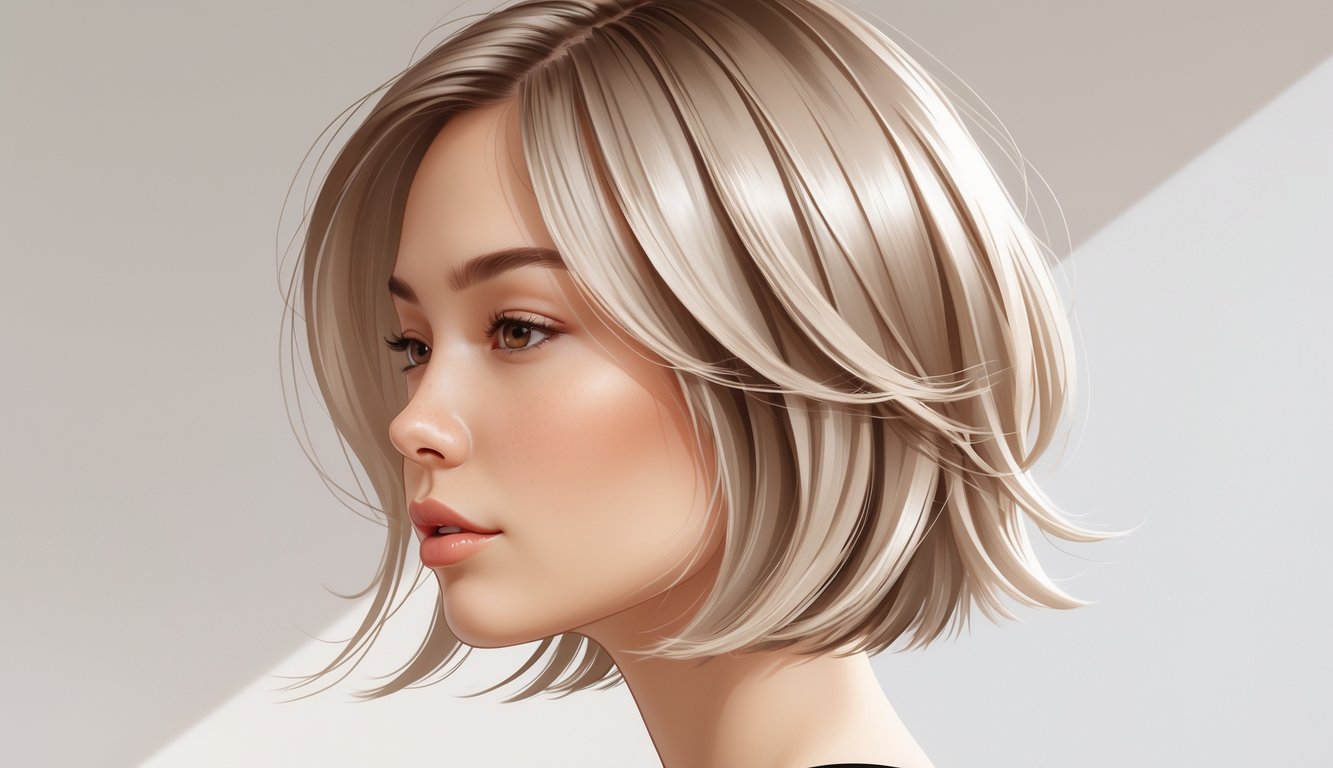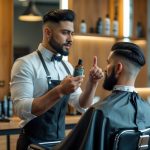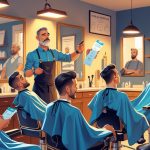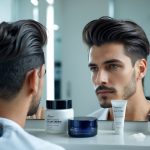
Maintaining the Lived-In, Subtle Layered Look
Skip conditioner? The layers puff out. Too much product? The movement’s gone. The sweet spot is elusive. Tools can’t save you from bad habits (my graveyard of curling irons is proof), and these “invisible” styles move so quietly, it’s like stylists are keeping secrets.
Easy At-Home Styling Routines
Texturizing sprays scare me. Use too much and my hair’s sticky, skip it and my layers are limp by lunch. I scrunch in a tiny bit while air-drying, maybe mousse if things look flat (Sebastian Whipped Crème works, but go lighter than you think—hairdressers are right about that). Sometimes I hit my roots with dry shampoo before bed so I wake up with some volume and no harsh lines—stole that from a bridal stylist who said dry shampoo is for styling, not just fixing grease.
Mussed texture reads as “I woke up like this,” but there’s a lot of fussing behind it. On lazy days, I twist up damp hair in a loose bun, let it fall out while I answer emails, and hope for the best. Skipping the brush gives better definition—somewhere between messy and styled. It’s not perfect, but it’s closer to what my stylist had in mind, and honestly, that’s good enough for me.
Recommended Products and Tools
Okay, real talk—if you’re still clinging to that old boar bristle brush, I dunno, maybe you like flat hair that collects every stray bit of lint? I don’t. My stylist keeps pushing this wide-tooth comb for detangling (which, fine, it doesn’t rip out half my hair), and then there’s the blow dryer with a diffuser. Allegedly it “coaxes out bends.” Sometimes I just give up and use my hands because, honestly, who has the energy? Air-styling with fingers is supposed to bring out texture. It’s like, sure, maybe. The wet-look thing? Don’t even try unless you’re using something like Ouai Hair Gelée, because everything else I tried basically turned my ends into crunchy noodles. Learned that the hard way. Twice.
Salt sprays—ugh, they’re tricky. Build-up happens faster than you think, so now I’m stuck rotating in a clarifying shampoo every week. Overkill? Maybe, but apparently, NYC stylists swear by it. (They also once told me to “embrace my natural wave,” so, grain of salt.) If you’re gonna splurge somewhere, make it heat protectant. I never remember sunscreen but somehow never forget heat spray for my hair. Priorities? Who knows. Oh, and keratin treatments? Yeah, those basically wiped out any point in having subtle layers for me, so now I avoid every “smoothing serum” that promises to tame all the things. They just make everything limp.
Trends to Watch in Subtle Haircuts
Nobody’s blasting these trends on TikTok with some catchy remix, let’s be honest. Invisible layers and ghost layers are just quietly appearing on salon menus. Supposedly, they add movement and volume but without those chunky, obvious steps. Sarah Potempa talked about ghost layering—she’s obsessed, and I guess so are the “external experts.” Is it really that customizable? Maybe. The “lived-in” look? Not new, just renamed every few months. Once it’s “diffused graduation,” next it’s “barely-there shaping.” Rebranding is the actual trend, if you ask me.
Salons love to claim they only use vertical scissor snips, but then I watched a Guy Tang reel and he’s just going at it with a razor. Both ways, if you skip trims, you’re doomed. Now, every product claims “soft definition,” “air-light texture,” “zero visible lines,” whatever that means. If you walk in with thick hair, they’ll pitch invisible layering for volume; if you’ve got fine hair, suddenly it’s about fullness. In reality, it’s always about “natural movement” and “minimal upkeep,” but those before-and-after pics? Never as effortless as promised.
Frequently Asked Questions
Pretending every haircut’s the same is like saying all running shoes are trail shoes. No one believes that. After years of sweating in the chair while someone with sharp objects hovers near my scalp, I can tell you: these little details about invisible layers and subtle fades? People are actually booking out salon appointments way in advance. Or so the stylists claim. Demand trends, commentary, whatever.
What’s the difference between invisible layers and traditional layering in haircuts?
Tried explaining invisible layers to my mom. She just stared at my head and said, “Are you sure you even got a haircut?” Traditional layers are obvious—like, you can literally see the steps. Invisible layers, though? They blend so well you can’t even tell where one length ends and another begins. Supposedly, this is the “subtle volume effect” all the celebrity stylists rave about in Glamour interviews. No one admits it, but honestly, hair just moves better without those harsh, choppy lines.
How do invisible layers enhance the look of thick hair?
If you’ve ever had thick hair, you know the triangle-head struggle. I spent years brushing out poof every morning. Invisible layers changed that—suddenly, the bulk around my jaw vanished and my ponytail stopped looking like a cleaning tool. Stylists talk about “weight removal” but keeping length, and, weirdly, it works. The volume spreads out instead of stacking up at the bottom. Once, someone asked if I’d gotten extensions. Nope, just clever interior thinning. But honestly, not every stylist can pull it off.
Can you explain the benefits of invisible layers for someone with thin hair?
Thin hair is just…a nightmare sometimes. One colorist whispered that “the right layering” could make my roots look fuller, but didn’t bother to explain it needed to be invisible. Now I know: these “airy” layers add movement and fake fullness in a way blunt cuts just can’t. Multiple stylists in MSN articles say the same thing—thin hair looks thicker with this trick. It feels like cheating. After my third micro-layer cut, I just stared at my part, trying to figure out why it didn’t look so flat. Still don’t really get it.
What are the latest techniques for cutting invisible layers into straight hair?
My barber told me not to move—like, at all. Apparently, one wrong snip ruins the whole vibe. She used feathering shears, doing this zig-zag thing I couldn’t follow, and kept saying “texturizing inside, not on top.” Is that a thing? Guess so. Supposedly, top salons are using razors only through the mid-lengths now, not the ends. That’s a 2025 thing, apparently. Some places say dry cutting is better for seeing the shape. Honestly, the cut took less time than the consultation, which was…unexpected.
Why are subtle fades becoming a go-to hairstyle choice in 2025?
I opened TikTok and boom—five videos about “low-maintenance invisible fades.” Who’s got time to style obvious layers every morning? Not me. Demand’s up, probably because subtle fades let your natural texture do the work. No round brush, no mousse, just vibes. Even trend analysts (yeah, that’s a job) at youprobablyneedahaircut.com keep saying people want soft shape without constant trims. My stylist claims “under-the-radar” layers mean your hair grows out without that awkward mullet phase. Is that true? I mean, my last grow-out didn’t look terrible, so maybe.
What should I ask my stylist for if I want a haircut with hidden layers?
So, the first time I tried asking for “hidden layers,” my stylist just laughed at me—which, honestly, fair. Apparently, stylists want you to talk about how you want your hair to move, not whatever trendy term you found on TikTok. Who knew? I just started saying stuff like, “Can you do that invisible shaping thing? I want it to feel lighter, but I don’t want those chunky steps or obvious layers.” I always have a couple of inspo pics on my phone, but half the time I’m just waving my hands around, trying to mime ‘fullness’ and ‘movement’ like a weirdo. Oh, and if your stylist grabs thinning shears and starts going at your ends like they’re pruning a hedge? Just nope out of there. The good kind of hidden layers is, I don’t know, kind of mysterious? Your hair feels lighter, looks better, but nobody can point out why. That’s the vibe.



